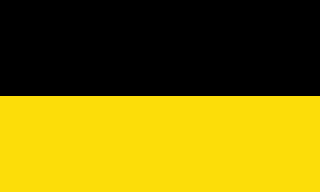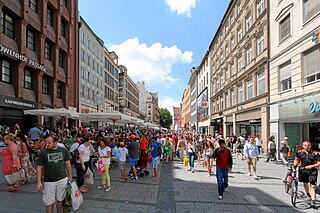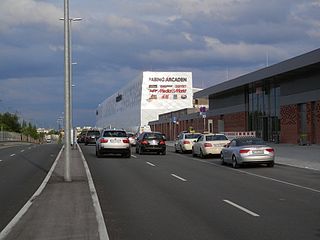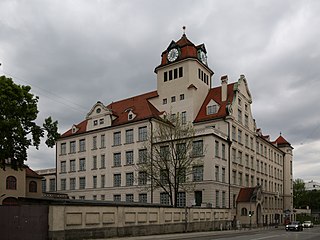
The Munich U-Bahn is an electric rail rapid transit network in Munich, Germany. The system began operation in 1971, and is operated by the municipally owned Münchner Verkehrsgesellschaft. The network is integrated into the Münchner Verkehrs- und Tarifverbund and interconnected with the Munich S-Bahn. The U-Bahn currently comprises eight lines, serving 96 stations, and encompassing 103.1 kilometres (64.1 mi) of routes.

Pasing is a district in the city of Munich, Germany, and part of the borough Pasing-Obermenzing.

Marienplatz is a central square in the city centre of Munich, Germany. It has been the city's main square since 1158.

Munich Marienplatz is an important stop on the Munich S-Bahn and U-Bahn network, located under the square of the same name in Munich's city centre. The S-Bahn lines , , , , , and intersect with the U-Bahn lines and . The station is one of the most frequently used stations in the network, with up to 24,400 people transferring and 8,000 passengers entering or exiting each hour. In 2007, 175,400 people used the station daily on weekdays, including entries, exits and transfers.

Munich-Pasing is a railway station in the west of Munich. It is the third-largest station in the city, after München Hauptbahnhof and München Ost.

Munich-Laim station is a station on the trunk line of the Munich S-Bahn between Munich Central Station and München-Pasing station. It is part of a large rail precinct, including Munich Laim marshalling yard. It has three platform tracks and is classified by Deutsche Bahn as a category 3 station.

The Munich tramway is the tramway network for the city of Munich in Germany. Today it is operated by the municipally owned Münchner Verkehrsgesellschaft and is known officially and colloquially as the Tram. Previous operators have included Société Anonyme des Tramways de Munich, the Münchner Trambahn-Aktiengesellschaft, the Städtische Straßenbahnen and the Straßenbahn München.

Maxvorstadt is a central borough of Munich, Bavaria, Germany and forms the Stadtbezirk (borough) 3 Maxvorstadt. Since 1992, this borough comprises the former boroughs 5, 6 and 7.

The Dachauer Straße is the longest street in Munich with a length of 11.2 km and it received its name since it is the connecting road to Dachau Palace. In the north of Munich, it is part of the Bundesstraße 304.

The Pasing Town Hall is the former town hall of the independent city of Pasing. Pasing has been a district of Munich since 1938.

The Villenkolonie Pasing I is a single-family house colony in Munich-Pasing.

The following outline is provided as an overview of and topical guide to Munich:

The Kaufingerstraße is one of the oldest streets in Munich and, together with the Neuhauser Straße, one of the most important shopping streets in Munich.

The Nordumgehung Pasing is a bypass that leads around the center of Pasing and the Bundesstraße 2.

The Landsberger Straße is one of the main arterial roads in Munich.

Boschetsrieder Straße is an inner city street in the Munich districts of Thalkirchen, Obersendling and Forstenried/Am Waldfriedhof, which runs west from Bundesstraße 11 on the Isar hillside to Kreuzhof, where it continues as the Fürstenrieder Straße.

The Goldschmiedplatz is a 2.31-hectare urban open space at the northern end of Schleißheimer Straße in Munich's Hasenbergl district. It was originally a combined bus and train stop and is now a meeting place for residents and activity area. The founding family Goldschmied from the 14th century gave the square its name.

Leonrodplatz is a square in the Munich district of Neuhausen. It was named in 1927 after the former Bavarian Minister of Justice Leopold von Leonrod.





















